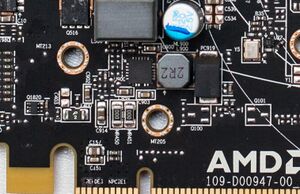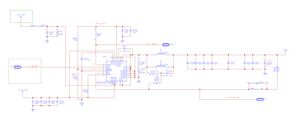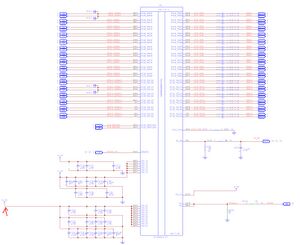More actions
| Display Rail on Polaris GPUs Explained | |
|---|---|
| Type | Circuit |
| Device(s) | RX 460, RX 470, RX 480, RX 560, RX 570, RX 580, RX 590 |
| Difficulty | ◉◉◌◌ Medium |
In this section, we will discuss the Display Rail on Polaris GPUs, including its controller circuit, usage, and common issues.
The Controller Circuit
Often referred to as the 0.8V rail, the Display Rail is typically controlled by either the GS9238 or the APW8713 step-down voltage converters. These controllers take 3.3V (or in some cases 12V_BUS) and convert it to 0.8V. Sapphire cards, on the other hand, may use an MPS NB671 for the Display Rail buck converter, which has a slightly different pinout.



While the markings on the schematic and board may vary between GPU models, the circuit design is typically consistent.
It's important to note that the GS9238 generates its own 5V on the VCC pin and does not require external power, except for Vin. In contrast, the APW8713 needs external 5V on its VCC pin to operate, which it receives from the 5V Rail on Polaris GPUs.
The Enable signal comes from the POK pin of the 1.8V Rail on Polaris GPUs, which is the gate of an NPN transistor, shorting the EN signal to GND, as depicted in Figure 3.
Usage
The Display Rail, as the name implies, powers the display components of the GPU, as shown in Figure 4.
Inconsistencies in the output voltage can lead to issues like flickering displays. In cases where the controller is faulty and does not output voltage but still produces a POK signal, the card may appear to "work" but without displaying anything.

Common Problems
No Voltage Output
When encountering a missing voltage rail, begin by measuring the VCC and EN pins of the controller, ensuring that both are active high. The MPS NB671 generates its own VCC, so if it's missing, the buck converter itself may be faulty.
If VCC and EN are both confirmed to be present, check if Vin is being provided to the controller. Sometimes, the resistors between the voltage source and the controller can develop high resistance or become open, preventing the controller from receiving power.
If Vin is also confirmed to be present, verify that the feedback resistors have the correct values as shown in Figure 2.
Short or Very Low Resistance
The Display Rail is designed to have low resistance, but if the resistance measures very low (sub 5 Ohms), this could indicate a dead GPU. Nonetheless, it's advisable to inspect for any potentially shorted capacitors using the method described here: Short Circuits - Repair Basics
No POK Signal
The POK signal from this controller is responsible for enabling Vmem and VDDCI. If the controller is not producing a POK signal, check the FB circuit. If everything appears to be in order, replace the controller.
